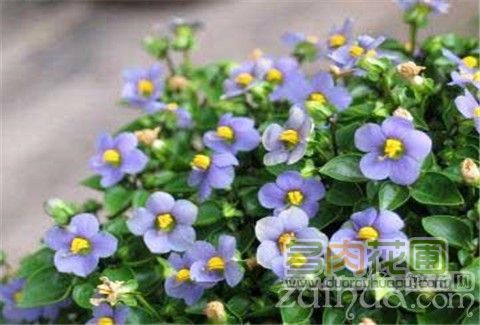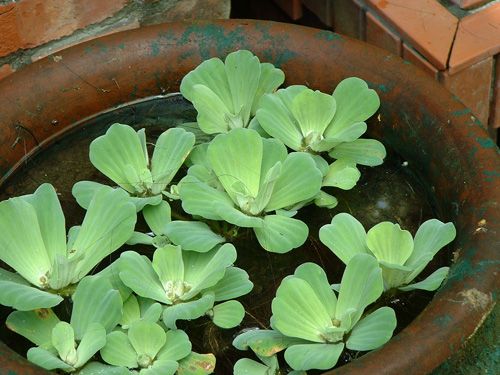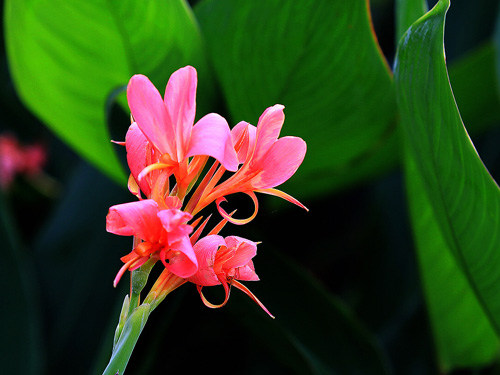Cultivation and management methods of Zili flower (water bamboo taro)
Re-bloom (water bamboo taro)
Scientific name: thalia dealbata
Aliases: water bamboo taro, water lotus banana, Talia.
Family and genus: Taro family Talia
Morphological characteristics: perennial Tingshui herbs, plant height 2m. The whole plant is covered with white powder, the leaves are ovate-lanceolate, grayish blue, with purple edges, 50 cm long and 25 cm wide. The petiole is extremely long. Compound raceme with small, pansy flowers. The bracts are like birds.
Ecological habits: grow well in slightly alkaline soil. Good warm, wet, sunny climate environment, not cold-resistant, resistant to semi-overcast, afraid of drought. The suitable temperature for growth is 20-30 degrees Celsius, and the growth stops below 10 degrees Celsius. Winter temperature can not be lower than 0 degrees Celsius, can withstand a short time of-5 degrees Celsius low temperature. After the beginning of winter, the aboveground parts gradually withered and died, overwintering with roots in the mud.
The method of propagation: it was cultivated by rhizome. In early spring, the rhizomes with 1 or 2 buds were cut from the mother plant and planted in the plate. Before planting, the roots were fertilized with sufficient base fertilizer. Peanut bran and bone meal were better put into the pool for maintenance, and new plants were to grow and grow in the pond.
Cultivation management: keep the soil moist during the growing period of indoor cultivation, spray more water on the leaves, and apply fertilizer once a month. Open-air planting, summer high temperature, strong light should be appropriate shade (but the author see Wuhan planting unshaded). Cut off the overhigh growing branches and damaged leaves, and properly cut the overdense plants to facilitate ventilation and light transmission. The ramets are divided once every 2-3 years.
Flowering: summer and autumn.
Flower words: fresh and lovely.
Garden use: beautiful plant type, wine stripping, purple flowers and interesting flowers. Waterscape greening, wetland landscape background, pot ornamental.
Species identification: similar to the plant type and leaf shape of aquatic canna, the flowers grow in shape, the petiole is very long, while the canna Finch stem is erect and the petiole is very short.

(1) temperature and environment: Peacock taro originated in Brazil, like warm, humid semi-shady environment, afraid of low temperature and dry wind, poor resistance to low temperature, avoid sun exposure, and should be cultivated in shade in summer. When the temperature is higher than 30 ℃, the leaf edge is scorched, the new buds germinate less, and the leaves turn yellow, so water should be sprayed frequently to keep moisture and cool down. There should be plenty of sunshine in winter.
(2) soil: Peacock bamboo taro prefers slightly acidic rotten leaf soil or culture soil with good drainage, fertile and loose. The cultivated soil can be mixed with a small amount of mature base fertilizer, rotten leaf soil, peat soil and river sand.
(3) Water and fertilizer: peacock bamboo taro likes a humid environment and should be given sufficient water in the growing season. If low temperature dormancy in winter, it is necessary to control watering, keep the basin soil not dry, after pulling out new leaves in the next spring, and then gradually watering normally. Peacock bamboo taro is topdressing liquid fertilizer once a month in the growing season to supplement the nutrients needed for the replacement of new and old leaves, and can promote strong plants and bright leaves. When lack of fertilizer, the plant becomes obviously short, the leaf color is yellowish, and the metal luster is not new. The application of fertilizer should be based on phosphorus and potassium, and there should not be too much nitrogen fertilizer. Generally, 0.2% liquid fertilizer is sprayed directly on the leaf surface and washed with a small amount of water to prevent fertilizer damage. Phosphorus and potassium fertilizer is also very beneficial to the germination and growth of new buds. Fertilization should be stopped in winter.
(4) pest control: there are few diseases and insect pests in peacock taro, but under the condition of dry air and poor ventilation, it is easy to grow shell insects and whitefly, which can be sprayed with 1000 times of 25% imidophos emulsion or 40% omethoate 1500 times.
That's all I know about peacock taro today. I hope it will be helpful for flower friends to read this article. If you want to know more about peacock taro, please continue to pay attention to the succulent flower bed, we will provide you with more related knowledge!
How to raise Thalia dealbata and how to breed Zuli Flower how to breed Zili Flower Business Cards and points for attention the introduction of Zili flower alias water bamboo taro, water lotus banana, Latin name: Thalia dealbata. Bamboo taro family, Talia plants, perennial water herbs. Leaves ovate-lanceolate, grayish blue, margin purple, long 50cm, wide 25cm. Compound raceme with small, pansy flowers. The whole plant is covered with white powder. Temperate zone is an excellent greenhouse flower, the flower stalk can be more than 2 meters high. Perennial herbs, leaves ovate-lanceolate, light grayish blue, margin purple, long 50cm, wide 25cm. Compound raceme, flowers small, pansy, the whole plant with white powder. The morphological characteristics of Zaili flower are perennial water herbs, leaves ovate-lanceolate, light grayish blue, margin purple, long 50cm, wide 25cm. Compound raceme with small, pansy flowers. The whole plant is covered with white powder. Temperate zone is an excellent greenhouse flower, the flower stalk can be more than 2 meters high. In recent years, a kind of tall water flower with high ornamental value has been introduced into our country, which is named in memory of the German botanist Johnny Sayer. Including 12 species born in swamps. The ecological habits of Zaolihua prefer a warm, wet, sunny climate, which is not cold-resistant, and the aboveground parts gradually die after winter. Spend the winter with roots in the mud. Grow well in slightly alkaline soil. The optimum growth temperature was 20 ~ 30 ℃, and stopped growing when it was lower than 10 ℃. The winter temperature can not be lower than 0 ℃ and can withstand the low temperature of-5 ℃ for a short time. After the beginning of winter, the aboveground parts gradually withered and died, overwintering with roots in the mud. Grow well in slightly alkaline soil. Good warm, wet, sunny climate environment, not cold-resistant, resistant to semi-overcast, afraid of drought. The mode of propagation of Rhizoma Rehmanniae and the ramet of rhizome. In early spring, the rhizome with 1 or 2 buds was cut from the mother plant, planted in the basin, applied sufficient fertilizer (peanut bran and bone meal was better), and maintained in the pool. The cultivation technique of Rhizoma Rehmanniae was cultivated by rhizome ramet. When planting, generally 10 buds per clump, 1-2 clumps per square meter. In early spring, the rhizomes with 1 or 2 buds were cut from the mother plant and planted in the plate. Before planting, the roots were fertilized with sufficient base fertilizer. Peanut bran and bone meal were better put into the pool for maintenance, and new plants were to grow and grow in the pond. Keep the soil moist during the growing period of indoor cultivation, spray more water on the leaves, and apply fertilizer once a month. Open-air planting, summer high temperature, strong light should be appropriate shade (but the author see Wuhan planting unshaded). Cut off the overhigh growing branches and damaged leaves, and properly cut the overdense plants to facilitate ventilation and light transmission. It is common to have a ramet every 2-3 years. The disease control of Zaolihua is generally free of diseases and insect pests, and it will not be swallowed by fish in the river. The plant type and leaf shape of Zaili flower are similar to those of aquatic canna, and the petiole is very long, while the canna Finch stem is erect and the petiole is very short. A tropical plant native to the southern United States and Mexico. A kind of tall water flower with high ornamental value was newly introduced into our country, which was named in memory of German botanist Johnny Sayer. Main planting cities: Haikou, Sanya, Qionghai, Kaohsiung, Tainan, Shenzhen, Zhanjiang, Zhongshan, Zhuhai, Macao, Hong Kong, Nanning, Qinzhou Beihai, Maoming, Jinghong. The function of Zili flower landscape use Zili flower plant shape is beautiful, free and easy, the leaf color is green and lovely, it is the top-grade flower of waterscape green flower, or it can be used as potted ornamental. The garden use of Zili flower plant is tall and beautiful, the huge green leaf is similar to banana leaf, the leaf color is green and lovely, the inflorescence is higher than the leaf surface, graceful and graceful, the blue-purple flower is elegant and chic, it is the top-grade flower of waterscape greening, and has the reputation of "bird of paradise on water". In addition to ornamental, Zili flower also has the role of purifying water quality, is an important waterscape flower, often planted in ponds or wetlands, can also be potted ornamental or planted in the courtyard water landscape. The flower language of the force flower again the flower language of the force flower: fresh and lovely. Zili Hua pictures
- Prev

Introduction and ecological habits of Dazhu (Chinese cabbage and water lotus)
Pistiastratiotes alias: water lotus, duckweed, water lotus, fat pig grass, water hibiscus, water lotus family: morphological characteristics of the genus Artemisia: perennial floating herbs. Stoloniferous, leaves basal, rosette clustered, sessile
- Next

Cultivation and management methods of aquatic canna (flower and leaf canna)
Aquatic canna (Canna mosaic) scientific name: cannaglauca alias: Florida Canna: Canna genus of Canna family: morphological characteristics: perennial root herbs, dwarf, plant height 50-80 cm. With rhizomatous tubers, leaves broadly elliptic, alternate
Related
- Fuxing push coffee new agricultural production and marketing class: lack of small-scale processing plants
- Jujube rice field leisure farm deep ploughing Yilan for five years to create a space for organic food and play
- Nongyu Farm-A trial of organic papaya for brave women with advanced technology
- Four points for attention in the prevention and control of diseases and insect pests of edible fungi
- How to add nutrient solution to Edible Fungi
- Is there any good way to control edible fungus mites?
- Open Inoculation Technology of Edible Fungi
- Is there any clever way to use fertilizer for edible fungus in winter?
- What agents are used to kill the pathogens of edible fungi in the mushroom shed?
- Rapid drying of Edible Fungi

